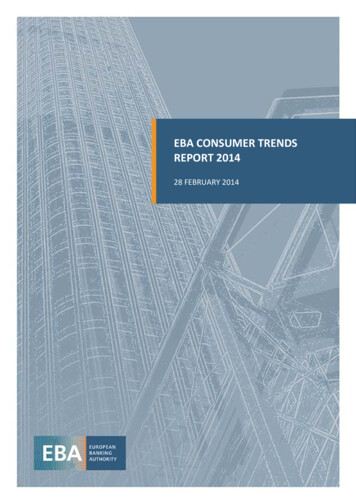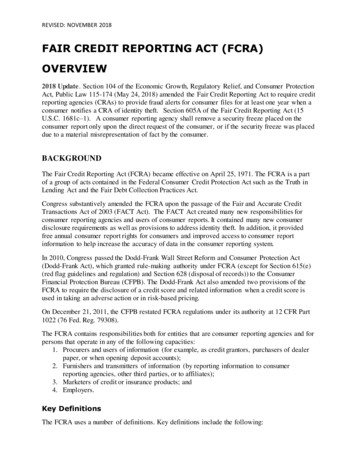
Transcription
RUNNING TITLE COMES HERE IN RUNNING TITLE STYLEEBA CONSUMER TRENDSREPORT 201428 FEBRUARY 20141
EBA CONSUMER TRENDS REPORT 2014ContentsList of figures3Abbreviations4Executive Summary5Background7Trends and issues identified in 2013 and actions taken since then9Indebtedness and responsible creditMis-sellingTransparency and levels of chargesIssues related to specific productsSecurity of new technologiesNew forms of liquidity raising and fundingTrends and issues identified for 2014Household borrowingBank accountsTraditional payment methodsNon-traditional payment methodsVirtual currenciesCrowdfundingMis-sellingComparison websitesFinancial literacyAnnex 1: Methodology of data sources used9101212131415172326283132333636382
EBA CONSUMER TRENDS REPORT 2014List of figuresExhibit 1: Real growth in housing loans, year-on-year percentage change (base year: 2010) . 18Exhibit 2: Real growth of consumer credit, year-on-year percentage change (base year: 2010) . 19Exhibit 3: Year-to-year growth (December 2012 to December 2013) . 20Exhibit 4: Forecast of consumer credit – annual percentage change 2013-16 . 21Exhibit 5: Banked population as a % of 15 population. 25Exhibit 6: Payment transations in Europe (in millions) – history and forecast . 26Exhibit 7: Payment transactions per type, year and geographical region . 27Exhibit 8: Global share of alternative payment methods . 29Exhibit 9: Percentage of mobile users who access mobile banking information services . 30Exhibit 10: Global number of M-payment and E-payment transactions (billions) . 303
EBA CONSUMER TRENDS REPORT 2014AbbreviationsBSGBanking Stakeholder GroupCARRPDDirective on Credit Agreements Relating to Residential PropertyEBAEuropean Banking AuthorityECBEuropean Central BankEIOPAEuropean Insurance and Occupational Pensions AuthorityESAEuropean Supervisory AuthorityESMAEuropean Securities and Markets AuthorityEUEuropean UnionJCJoint Committee (of the three ESAs)MCDMortgage Credit DirectiveNSANational Supervisory AuthorityPADPayment Accounts DirectivePPIPayment Protection InsurancePOGProduct Oversight and GovernancePSDPayment Services DirectiveRTSRegulatory Technical Standard4
EBA CONSUMER TRENDS REPORT 2014Executive SummaryOne of the tasks of the European Banking Authority (EBA) is to collect, analyse and report onconsumer trends. In order to fulfil this mandate, the EBA publishes an annual Consumer TrendsReport. Each annual report sets out the trends the EBA has observed, identifies the consumerissues that may arise, or have arisen, from these trends, and describes the approaches the EBAwill be taking in that calendar year to address them.The market segments of relevance to the EBA comprise the ‘pure’ banking products that fall intothe mandate and scope of action of EBA’s consumer protection and financial innovation work.These include mortgages, personal loans, savings products, current accounts, credit/debit cardsand payment services.The trends identified for 2014 are best seen in the context of the trends that were identified inthe 2013 report, and the actions the EBA has taken since then to address issues arising from thosetrends. The actions include the publication of the following instruments:--EBA Opinion on Good Practices for Responsible Mortgage Lending;EBA Opinion on Good Practices for the Treatment of Borrowers in Payment Difficulties;EBA Consultation Paper on draft Regulatory Technical Standards (RTS) on the minimummonetary amount of professional indemnity insurance for mortgage credit intermediaries;EBA/ESMA Consultation Paper proposing to read across to the banking andinvestment/securities sectors the EIOPA complaints handling guidelines for the insurancesector;A Joint Position of the European Supervisory Authorities, setting out eight high-level principlesfor manufacturers’ product oversight and governance processes; andResponse to the European Commission consultation on crowdfunding, setting out the risksarising for fund seekers and fund providers when using the lending model of crowdfundingand providing an overview of the national approaches used in the EU-28.Looking towards the trends and issues for 2014, the report uses a wide set of sources, includinginput from national supervisory authorities (NSAs), complaints data from European Ombudsmen,views from EBA’s Banking Stakeholder Group (BSG), and reports and statistical datasets producedby third-party entities. These inputs suggest that the EBA should look at eight different trends andissue areas in 2014 and take the following actions to address them:With regard to household borrowing, the EBA will assess the merits of converting the Opinions ongood practices for responsible mortgage lending and for the treatment of borrowers in mortgagepayment difficulties into more binding legal instruments, such as EBA guidelines. The EBA will alsobe publishing the final version of the RTS on the minimum coverage level for professionalindemnity insurance for mortgage credit intermediaries, following the end of the consultationperiod in March 2014.5
EBA CONSUMER TRENDS REPORT 2014With regard to bank accounts and traditional payment methods, as well as non-traditionalpayment methods, the EBA will monitor the ongoing discussions of the proposed PaymentAccounts Directive (PAD) and the revised Payment Services Directive (PSD2), and will launch itsown initiatives where required. With regard to crowdfunding, the EBA will conduct furtheranalysis jointly with ESMA, to form a view on whether a European regulatory framework isrequired and, if so, what that framework should look like.With regard to mis-selling, the EBA will embark on phase 2 of the work on Product Oversight andGovernance, to develop more detailed requirements for the banking sector which build on theeight principles that have been published as a Joint Position. The EBA will also commence work onsales incentives by gathering the respective experience of NSAs followed by a legal assessment ofthe supervisory powers available to them, and will continue to work on self-placement of financialinstruments within the Joint Committee (JC).For the topic of comparison websites, the EBA will contribute to a JC initiative to develop a ‘Howto’ guide for consumers. With regard to financial literacy, the EBA will assess how best to fulfil itsmandate on financial literacy. In the meantime, the EBA’s work on product oversight andgovernance will consider requiring manufacturers to take into account the degree of financialcapability of consumers when developing and marketing products.6
EBA CONSUMER TRENDS REPORT 2014Background1.One of the tasks of the European Banking Authority (EBA) is to collect, analyse and report onconsumer trends, as laid down in Article 9(1)(a) of the EBA Regulation.1 In order to fulfil thismandate, the EBA publishes an annual Consumer Trends Report, and has done so inFebruary 2012 and March 2013. 2 Each annual report sets out the trends the EBA hasobserved, identifies the consumer issues that may arise, or have arisen, from these trends,and describes the approaches the EBA will be taking in that calendar year to address them.2.The market segments of relevance to the EBA comprise the ‘pure’ banking products that fallinto the mandate and scope of action of EBA’s consumer protection and financial innovationwork. These include mortgages, personal loans, savings products, current accounts,credit/debit cards and payment services.3.The 2014 iteration of the report builds on the reports published in previous years. In 2013,the report was mainly based on a survey by the EBA of the consumer protection prioritiesidentified by NSAs in the 27 EU Member States in their respective national markets. Thisapproach was repeated for the 2014 report but was supplemented by several measures theEBA took to increase the variety of information sources on which the report is based. Themeasures included:4.12-The acquisition and analysis of statistical datasets and reports produced byindependent research institutes and other organisations on the market trends acrossseveral categories of financial services, using the most recent data available. Thisincludes household borrowing, new product activity and emerging growth categories,market position and performance of leading national and international players, and indepth reports and forecasts of emerging new technologies such as mobile banking;-Input from the EBA’s BSG, the 30 members of which were asked to name the top fiveissues they thought the EBA should address in 2014; and-Complaints data on banking products received from both NSAs and nationalOmbudsmen across the EU.The increased number of sources is aimed at increasing the reliability and, hence, quality ofthe report and, as a result, at ensuring that the EBA will set the right priorities and tackle theright issues in 2014. The acquisition of cross-EU statistical datasets, in turn, was a way toSee uri OJ:L:2010:331:0012:0047:EN:pdfSee d-consumer-protection and rends-report7
EBA CONSUMER TRENDS REPORT 2014overcome the limited availability of consistent consumer and product data from the 28 NSAs.This cross-EU perspective inevitably means focusing on data that is comprehensive at thecost of omitting some more recent information that individual NSAs might have been able toprovide.5.The trends and topics that have emerged from the resultant analysis are set out in thisreport, which presents a selection of the data and explains the measures the EBA will betaking in 2014 to address them. The report will start, however, with a review of the trendsthat were identified in last year’s report and the actions the EBA and NSAs have taken sincethen.8
EBA CONSUMER TRENDS REPORT 2014Trends and issues identified in 2013 andactions taken since then6.7.Last year’s report was developed at the end of 2012 and published in March 2013. 3 Itidentified the following trends and issues as relevant for the EBA in 2013, based on a surveythe EBA undertook of NSAs in the (then) 27 EU Member States:-Indebtedness and responsible credit;-Mis-selling;-Transparency and levels of charges;-Issues related to specific products (foreign currency loans, complex products, PPI);-Security of new technologies used for banking services; and-Emerging new forms of liquidity raising.This part of the report sets out which actions have been undertaken by the EBA, NSAs andother relevant institutions since the publication of the report.Indebtedness and responsible credit8.The global financial crisis and the ongoing challenging economic environment had led toconcerns in many Member States about consumer over-indebtedness, arrears andforeclosures, and about how such risks might be mitigated, including through responsiblelending and credit practices. Concerns that were highlighted in the 2013 report included bothmortgage lending and other lending to consumers, such as overdrafts, term loans, hirepurchase, credit cards and other personal loans.9.In response, the EBA monitored the progress of the negotiation of the Mortgage CreditDirective (Directive on credit agreements relating to residential property, CARRPD), whichshould provide EU solutions to some of the issues identified in relation to indebtedness andresponsible lending in the mortgages sector.10. In particular, the MCD will require lenders to assess the creditworthiness of applicants beforegranting a loan and encourage them to exercise reasonable forbearance. On this particularpoint, the EBA published in June 2013 two Opinions on good practices for (i) responsiblemortgage lending and (ii) the treatment of borrowers in mortgage payment difficulties.3See trends-report9
EBA CONSUMER TRENDS REPORT 201411. As explained in more detail below, in the second part of the consumer trends identified for2014, the EBA envisages assessing the effectiveness of these opinions, so as to form a viewon whether there is a case to ‘convert’ them into a more binding legal instrument, such asthe EBA guidelines.12. The MCD also introduces requirements related to the professionalism and admission ofmortgage credit intermediaries. To that end, the EBA has fulfilled a mandate given to it inArticle 29 of the MCD by publishing, on 19 December 2013, a Consultation Paper on draft RTSon the minimum monetary amount of the professional indemnity insurance or comparableguarantee for mortgage credit intermediaries. 4 The deadline for responses is 18 March 2014,at which point the EBA will produce a feedback statement and the final RTS.13. Some NSAs have also taken measures at a national level in respect of responsible credit andarrears handling, as high levels of indebtedness have led to consumers in arrears. Forexample, one NSA refined its regulatory approach to develop a recommendation related toconsumer protection issues arising as a result of practices by debt collection organisations.14. Another three NSAs reported having revised existing guidelines, recommendations andprovisions. One of these revised the existing set of requirements and principles forresponsible lending; another developed a revised code of conduct on mortgage arrearsfocusing on the interaction between lenders and borrowers, the treatment of un-cooperativeborrowers, additional rules in relation to provision of information to borrowers, and newrules in relation to appeals.15. Additionally, four NSAs introduced new legislation or regulations. In one case, the new lawsets a specific legal framework for debt restructuring related to borrowers with low annualincome and who also fulfil other specific conditions. One other NSA enacted personalinsolvency legislation, while another submitted a proposal to its national governmentrequiring banks clearly to show how amortisation affects a household’s finances in the longrun.Mis-selling16. In last year’s report, a number of NSAs continued to be concerned about the scope for misselling of products, which was compounded by the increased incentives for some financialinstitutions to rebuild their balance sheets and explore revenue opportunities and profit indifficult economic conditions. This included the scope for inadvertent mis-selling byintermediaries who do not understand the products they are distributing. Related to thisissue, one NSA had also specifically commented on an increase in customer complaints aboutthe behaviour of its banks and other financial institutions over the previous year, and thisregulator’s increased focus on how institutions are handling customer complaints.4See rmortgage-credit-intermediaries10
EBA CONSUMER TRENDS REPORT 201417. Following last year’s report, the EBA started several initiatives to address the issue withregard to both the drivers of mis-selling and the way financial institutions deal with theconsequences of mis-selling in terms of complaints handling.18. With regard to the consequences of mis-selling, the EBA proposed within the JC of the threeEuropean Supervisory Authorities (ESAs) to read across to the banking sector the complaintshandling guidelines already in place for the insurance sector as developed by the EuropeanInsurance and Occupational Pensions Authority (EIOPA). The EBA did so jointly with theEuropean Securities and Markets Authority (ESMA), which proposed the same for theinvestment and securities sector.19. The objective of this initiative is to provide EU consumers with a single set of complaintshandling arrangements, irrespective of the type of product or the geographical location ofthe consumer and the financial institution. Identical guidelines will also allow firms tostreamline and standardise their complaints handling arrangements across product rangesand will allow national regulators to supervise the same requirements across all sectors offinancial services. The Consultation Paper was published on 6 November 2013, with aresponse deadline of 7 February 2014. 520. With regard to the drivers of mis-selling, work was undertaken by the EBA within the JC ofthe three ESAs to address one of the drivers of mis-selling: the failure by manufacturers tohave proper product oversight and governance processes in place. The design of financialproducts and services poses risks to consumers when the target market is not correctlyidentified and when the objectives and characteristics of the target market are not dulytaken into account in the marketing of products to consumers.21. To address the issue, which has arisen across the three sectors of banking, insurance andsecurities, the JC developed eight high-level principles that stress the importance of thecontrols that manufacturers need to have in place before launching their products. The aim isto discourage products and services that may cause consumer detriment from entering themarket and thus ultimately enhance consumers' confidence in financial markets.22. The principles were published on 28 November 2013 in the form of a Joint Position of thethree ESAs. 6 A Joint Position is not directly addressed at market participants or competentauthorities but provides a high-level, consistent basis for the development of more detailedrequirements addressed at manufacturers by each ESA in their respective sectors. In 2014,the EBA will embark on phase 2 of this work, as outlined in more detail further below.23. A particular variant of potential mis-selling that was addressed by the EBA in 2013 is that of‘self-placement’. Self-placement refers to the practice of credit institutions selling their own5See and-banking-eba-sectors6See anceprocesses11
EBA CONSUMER TRENDS REPORT 2014financial instruments – such as common equity shares, preference shares, hybrid securitiesand debt – to their existing depositors. Self-placement can cause consumer detriment if thefinancial instruments are sold to banking customers without making them aware of the risks,by providing misleading information, or declaring the product as being ‘as safe as a deposit’.Jointly with ESMA, the EBA undertook preliminary work in 2013 with NSAs to assess theextent to which self-placement occurs across the European Union, and the nature of anyrisks seen. The work will continue in 2014 within the JC.Transparency and levels of charges24. Concerns that had been identified by national authorities in 2013 referred to the trend forsome financial institutions to increase fees and charges, or introduce new ‘administrative’fees and charges, for certain loan repayments (particularly when repayments are late), whichfurther burden indebted consumers. Some NSAs have also identified a lack of transparency incharges being levied for overdrafts, and some disregard for the disclosure requirements ofthe Consumer Credit Directive. A number of regulators were considering whether suchbehaviours are consistent with their national laws and regulations, and whether clarificationor regulatory intervention was required.25. As the European Commission was in the process of proposing a Payment Accounts Directive(PAD) that would give several mandates to the EBA on the transparency of fees, the EBA didnot start any of its own initiatives in 2013 to address the issue. 7 The Commission eventuallypublished the draft PAD proposal on 8 May 2013, and the EBA has since then monitored thelegislative process and liaised with the Commission and the European Parliament to clarifythe proposed EBA mandates. Depending on the legislative progress of the PAD, the EBA willcommence work on the implementation of the proposed mandates in mid-2014 (for details,see the second part of this report).Issues related to specific products26. The 2013 report continued to highlight concerns by NSAs about unnecessarily complexproducts being offered to consumers who do not understand the products or the risks theyinvolve. Concerns were related to the quality of information provided about such productsand whether the information can be readily understood by those to whom the products areoffered.27. Particular examples that were mentioned in the report include loans taken out in foreigncurrencies (including foreign currency mortgage loans), payment protection insurance (PPI),credit protection insurance in connection with loans, and other complex products that aredifficult for consumers to understand in terms of the trade-offs between charges, risks,returns and guarantees. Three NSAs had the topic of PPI as their priority, of which two have7See eon-bank-accounts12
EBA CONSUMER TRENDS REPORT 2014analysed sales procedures and redress to consumers has been decided upon. One NSA ispreparing legislation in order to apply the same regulation to all intermediaries offeringfinancial services, and this would include qualification requirements.28. Since the publication of the report, the EBA has taken no specific measures to address issuesarising from these particular products. Instead, the EBA has embarked on a more generalapproach to address one of the causal drivers of detriment arising from the sale of the aboveproducts. Within the framework of the JC, the EBA developed and published eight high-levelprinciples to address insufficient product oversight and governance processes bymanufacturers. 829. The pending second phase of developing more banking-specific product oversight andgovernance requirements is intended to contain the risk of consumer detriment arising fromthe mis-selling of banking products, including foreign currency loans, PPI and complexproducts.30. At a national level, some NSAs took steps to address the issue of foreign currency loans. OneNSA published new requirements at the beginning of 2013, setting standards for the riskmanagement and granting of foreign currency loans and loans with repayment vehicles.These were aimed at the unification of existing standards and the full implementation ofESRB recommendations on foreign currency lending (ESRB/2011/1). As a result, the NSA inquestion observed a notable decrease in the number of such loans.Security of new technologies31. Last year’s report raised concerns about the security and fraud risks that continue to arise inconnection with new banking and payment technologies. These include the need to ensurethat all providers have appropriate systems and controls in place to manage the risks and todeliver on their consumer protection obligations, including where services are providedacross national borders.32. Since the publication of the report, the EBA has started working on the topics of mobilepayments and alternative payment channels. As a first step, a risk analysis has been carriedout for mobile payments. As a next step, the EBA will integrate the various payment-relatedtopics into a single initiative, including security issues in this work.33. Furthermore, in summer 2013, and following the publication of the European Commission’sproposal for a review of PSD2, the EBA started attending the meetings of the EuropeanForum on the Security of Retail Payments (SecuRe Pay) of the European Central Bank (ECB).SecurRe Pay is a voluntary cooperative initiative between relevant authorities from theEuropean Economic Area – i.e. supervisors of payment service providers – formed with theobjective of facilitating common knowledge and understanding of issues related to the8See anceprocesses13
EBA CONSUMER TRENDS REPORT 2014security of electronic retail payment services and instruments. Where considered necessary,SecuRe Pay can issue recommendations.34. The mandates that the EBA would receive if the PSD2 proposal was adopted foresee the EBAworking closely with the ECB and SecuRe Pay to implement those mandates that are relatedto security. This work is expected to start in the second half of 2014 (for details, see thesecond part of the report).New forms of liquidity raising and funding35. Lastly, the 2013 report identified new models of liquidity raising and funding. One of these is‘crowdfunding’ or ‘peer-to-peer’ lending, whereby groups of consumers are invited toparticipate in direct lending to other borrowers or enterprises, as an alternative to fundingfrom financial institutions. While such models may have their place, some regulators haveissued reminders to consumers to be aware of the risks that may be involved and the lack ofprotections underpinning some of these schemes.36. This new form of raising capital is typically put in place through an internet-based platformthat brings together individuals or companies looking for funds and those who are willing toprovide the funds. There are different models of crowdfunding – donations, rewards, profitsharing, lending, debt and equity are the most widely mentioned. These activities wereconsidered to be relevant by a number of NSAs and some have actually taken steps in orderto address their concerns.37. Since publication of the report, the EBA has started analysing the risks for fund seekers andfund providers when using the lending model. The result of this analysis was sent as an EBAresponse to the European Commission consultation on crowdfunding, with a view that themitigation of these risks will contribute to market actors having increased confidence in thisnew form of funding.38. Simultaneously, work was carried out in autumn 2013 with ESMA in the form of a jointsurvey of the 28 Member States to gauge the scale of the phenomenon and to identify anyrisks that may have materialised and the regulatory approaches taken by the 28 NSAs. Theresulting report is to be sent to the Commission to further contribute to the emergingEuropean approach to crowdfunding.14
EBA CONSUMER TRENDS REPORT 2014Trends and issues identified for 201439. As explained in the background section, the EBA identified the consumer trends for 2014using a wider choice of data and information sources than previously. The EBA approachedthe NSAs in the 28 Member States to identify the top consumer issues they are currentlyworking on. The EBA also acquired and analysed statistical datasets and reports produced byindependent research institutes and other organisations on the latest market trends acrossseveral categories of financial services. Throughout, the EBA has used the most recent datapoints available to do this. These categories included household borrowing, new productactivity and emerging growth areas, market position and performance of the leading nationaland international players, and in-depth reports and forecasts of emerging new technologies,such as mobile banking. The methodologies used by these external reports is summarised inAnnex 1.40. Furthermore, the EBA received input from the EBA’s BSG, the 30 members of which wereasked to name the top five issues they thought the EBA should address in 2014, and analysedcomplaints data on banking products requested and received from both NSAs and nationalOmbudsmen across the EU.41. The increased number of sources is intended to improve the reliability and, hence, quality ofthe report and, as a result, to ensure that the EBA will set the right priorities and tackle theright issues in 2014. The acquisition of statistical cross-EU datasets was, in turn, a way toovercome the limited availability of consistent consumer and product data from the 28 NSAsindividually (although it came at the cost of having to ignore more recent data that a fewNSAs were able to provide individually).42. The analysis of the above data and information suggests that the EBA should assess thefollowing issues in 2014:-household borrowing;-bank account switching and fees;-traditional payment methods such as cash, debit and credit cards, cheques, banktransfers;-non-traditional payment methods, such as mobile payments and e-wallets;-digital currencies;-crowdfunding;-mis-selling of products;-comparison websites; and-financial literacy.15
EBA CONSUMER TRENDS REPORT 201443. A comparison of the list above with the list of trends and issues that had been identified in2013 reveals that many trends, or variations thereof, have remained an issue in 2014. Forexample, matters related to household borrowing, i.e. the means of financing available tohouseholds for the purchase of residential properties and for some of their consumptionexpenditure remain important. Macro-economic and social conditions appear to have furtherexacerbated this issue, resulting in concomitant high levels of indebtedness and borrowing.44. The topic of bank accounts, in turn, has increased in relevance and now includes the topic oftransparency and level of fees, as well as account switching. Furthermore, amongst the newforms of funding and liquidity raising, crowdfunding has attracted the greatest attentionacross the EU, as it provides an alternative to traditional channels of borrowing and lending.The European Commission, too, has taken an interest in the topic and published aconsultation paper on 3 October 2013. It provides additional impetus for the EBA to take aview on which, if any, regulatory measures are required to ensure that market actors canhave confidence in this new
consumer trends. In order to fulfil this mandate, the EBA publishes an annual Consumer Trends Report. Each annual report sets out the trends the EBA has observed, identifies the consumer issues that may arise, or have arisen, from these trends, and describes the approaches the EBA will be taking in that calendar year to address them.










